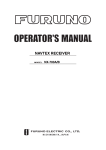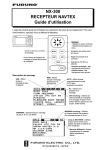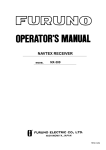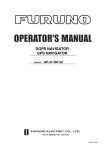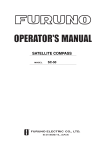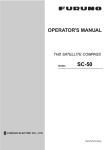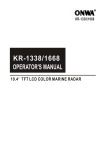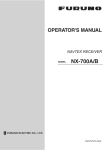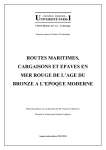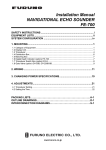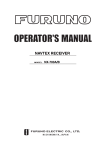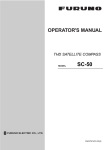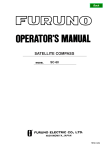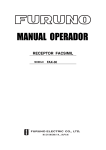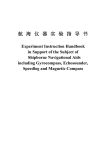Download NX300 Operator`s Manual L 5-25-12
Transcript
Back OPERATOR'S MANUAL NAVTEX RECEIVER MODEL NX-300 www.furuno.com The paper used in this manual is elemental chlorine free. ・FURUNO Authorized Distributor/Dealer 9-52 Ashihara-cho, Nishinomiya, 662-8580, JAPAN All rights reserved. Printed in China A : MAR . 2000 L : MAY 25, 2012 Pub. No. OME-56290-L (REFU ) NX-300 *00017195012* *00017195012* * 0 0 0 1 7 1 9 5 0 1 2 * IMPORTANT NOTICES General • This manual has been authored with simplified grammar, to meet the needs of international users. • The operator of this equipment must read and follow the descriptions in this manual. Wrong operation or maintenance can cancel the warranty or cause injury. • • • • Do not copy any part of this manual without written permission from FURUNO. • • • If this manual is lost or worn, contact your dealer about replacement. The contents of this manual and equipment specifications can change without notice. The example screens (or illustrations) shown in this manual can be different from the screens you see on your display. The screens you see depend on your system configuration and equipment settings. Save this manual for future reference. Any modification of the equipment (including software) by persons not authorized by FURUNO will cancel the warranty. All brand and product names are trademarks, registered trademarks or service marks of their respective holders. How to discard this product Discard this product according to local regulations for the disposal of industrial waste. For disposal in the USA, see the homepage of the Electronics Industries Alliance (http://www.eiae.org/) for the correct method of disposal. How to discard a used battery Some FURUNO products have a battery(ies). To see if your product has a battery, see the chapter on Maintenance. Follow the instructions below if a battery is used. Tape the + and terminals of battery before disposal to prevent fire, heat generation caused by short circuit. In the European Union The crossed-out trash can symbol indicates that all types of batteries must not be discarded in standard trash, or at a trash site. Take the used batteries to a battery collection site according to your national legislation and the Batteries Directive 2006/66/EU. Cd In the USA The Mobius loop symbol (three chasing arrows) indicates that Ni-Cd and lead-acid rechargeable batteries must be recycled. Take the used batteries to a battery collection site according to local laws. Ni-Cd Pb In the other countries There are no international standards for the battery recycle symbol. The number of symbols can increase when the other countries make their own recycling symbols in the future. i SAFETY INSTRUCTIONS Safety Instructions for the Operator WARNING Do not open the cover of the equipment. Only qualified personnel should work inside the equipment. CAUTION Keep heater away from equipment. A heater can melt the equipment's power cord, which can cause fire or electrical shock. Use the proper fuse. Immediately turn off the power at the ship's mains switchboard if water or foreign object falls into the equipment or the equipment is emitting smoke or fire. Continued use of the equipment can cause fire, electrical shock and serious injury. Do not disassemble or modify the equipment. Fire, electrical shock or serious injury can result. ii Use of the wrong fuse can cause fire or equipment damage. Do not operate the equipment with wet hands. Electrical shock can result. Safety Instructions for the Installer CAUTION WARNING Do not open the cover unless totally familiar with electrical circuits and service manual. Improper handling can result in electrical shock. Turn off the power at the ship's mains switchboard before beginning the installation. Post a warning sign near the switchboard to ensure that the power will not be applied while the equipment is being installed. Serious injury or death can result if the power is not turned off, or is applied while the equipment is being installed. Ground the equipment to prevent mutual interference. Confirm that power supply voltage is compatible with the voltage rating of the equipment. Connection to the wrong power supply can cause fire or equipment damage. The voltage rating appears on the label at the rear of the equipment. Observe the following compass safe distances to prevent interference to a magnetic compass: NX-300 Standard compass Steering compass 0.5 m 0.3 m iii CONTENTS FOREWORD ................................................................................................................... vi A Word to NX-300 Owners .................................................................................................................. vi Features ............................................................................................................................................. vii SYSTEM CONFIGURATION ........................................................................................ viii EQUIPMENT LISTS........................................................................................................ ix 1. PRINCIPLE OF NAVTEX SYSTEM.........................................................................1-1 1.1 How NAVTEX Works ..................................................................................................................1-1 1.2 NAVTEX System Operation........................................................................................................1-1 1.3 Message Format.........................................................................................................................1-2 1.4 Display Indications......................................................................................................................1-3 1.5 NAVTEX Station Map .................................................................................................................1-4 1.6 NAVTEX Station List...................................................................................................................1-5 2. OPERATION ............................................................................................................2-1 2.1 Control Description .....................................................................................................................2-1 2.2 Turning the Power On/Off...........................................................................................................2-1 2.3 Adjusting Dimmer and Contrast..................................................................................................2-2 2.4 Menu Operation Overview..........................................................................................................2-2 2.5 Selecting Stations .......................................................................................................................2-3 2.6 Selecting Messages ...................................................................................................................2-4 2.7 Setting Functions (FUNCTIONS menu) .....................................................................................2-5 2.8 Selecting Language....................................................................................................................2-9 2.9 Displaying Messages..................................................................................................................2-9 2.10 Sample Messages ..................................................................................................................2-10 2.11 Displaying Navigation Data .................................................................................................... 2-11 2.12 Selecting Receive Frequency.................................................................................................2-12 3. SYSTEM MENU.......................................................................................................3-1 3.1 Units of Measurement ................................................................................................................3-1 3.2 Time Difference (using local time) ..............................................................................................3-2 3.3 Time Display...............................................................................................................................3-3 3.4 Default Setting ............................................................................................................................3-3 iv 3.5 Delete All Messages ...................................................................................................................3-4 3.6 User Display of Navigation Data.................................................................................................3-4 4. OTHER FUNCTIONS...............................................................................................4-1 4.1 DEMO Mode...............................................................................................................................4-1 4.2 VIEW Mode ................................................................................................................................4-1 4.3 All Clear ......................................................................................................................................4-1 4.4 Changing Received Message Log Window .................................................................................4-2 5. MAINTENANCE & TROUBLESHOOTING .............................................................5-1 5.1 Maintenance ...............................................................................................................................5-1 5.2 Diagnostic Test ...........................................................................................................................5-1 5.3 When the Battery Icon Appears..................................................................................................5-2 5.4 Replacement of Fuse .................................................................................................................5-3 6. INSTALLATION .......................................................................................................6-1 6.1 Installation of Display Unit ..........................................................................................................6-1 6.2 Installation of Antenna Unit.........................................................................................................6-2 6.3 Wiring .........................................................................................................................................6-3 6.4 Interfacing...................................................................................................................................6-4 MENU TREE ..............................................................................................................AP-1 SPECIFICATIONS ..................................................................................................... SP-1 PACKING LIST ............................................................................................................ A-1 OUTLINE DRAWINGS................................................................................................. D-1 INTERCONNECTION DIAGRAM ................................................................................ S-1 INDEX ................................................................................................................... index-1 Declaration of Conformity v FOREWORD A Word to NX-300 Owners Congratulations on your choice of the FURUNO NX-300 NAVTEX Receiver. We are confident that you will enjoy many years of operation with this fine piece of equipment. Since 1948, FURUNO Electric Company has enjoyed an enviable reputation for quality and reliability throughout the world. Our extensive global network of agents and dealers furthers this dedication to excellence. The NX-300 is just one of the many FURUNO developments in the field of marine radio communication. The NX-300 provides cost-effective price, high sensitivity and simple operation in one compact and light-weight unit. In addition to its fundamental function of receiving NAVTEX broadcasts, this unit can also function as nav data display when connected to navigation equipment. This unit is designed and constructed to ensure the user many years of trouble-free operation. To obtain full performance from the equipment, however, you should carefully read and follow the recommended procedures for installation, operation and maintenance. No machine can perform its intended functions unless it is installed and maintained properly. Thank you for considering and purchasing FURUNO equipment. For SOLAS vessels and ships Subject to formal inspection we recommend our NX-700 NAVTEX Receiver which meets the full requirements of IMO Resolution MSC.148(77). vi Features NAVTEX (Navigational Telex) is a worldwide coastal telex broadcasting system. Coastal NAVTEX broadcasting stations with specific ID's transmit Navigational warnings, Meteorological warnings, Search and Rescue (SAR) information and other navigational information for NAVTEX receiver-equipped vessels sailing in coastal waters. The FURUNO NX-300 NAVTEX receiver receives NAVTEX messages and automatically displays them together with station ID and message category information. The service range of a NAVTEX station is typically 200-400 nautical miles. A NAVTEX station normally broadcasts every 4 hours. The NAVTEX message is relevant for all types and sizes of vessels. The NX-300 is shipped from the factory equipped to receive 7 specific types of NAVTEX messages from all NAVTEX stations. However unnecessary stations can be rejected or necessary stations can be added by the "manual station selection" facility. If ship's position data is fed from navigation equipment, the NX-300 automatically decides in which NAVAREA the vessel is navigating, and selects stations. (NAVAREAs are geographical zones defined by the International Maritime Organization.) • Unattended operation once required data is entered. • Received data is not saved nor displayed when the error rate exceeds the percentage you set (max 39%). • No paper required • Designed for voluntary carriage on recreational craft and small workboats • Compact, stylish display and antenna units • Memory of up to 28,000 characters for last 72 hours • Navigation data can be fed through external input (connection with navigation aid required). • Bright 95 x 60 mm LCD with adjustable contrast and brilliance • Memory backup with a long-life lithium battery • Low power consumption vii SYSTEM CONFIGURATION H-field ANTENNA UNIT NX-3H-D Antenna Cable (10 m) NAVTEX RECEIVER NX-300-D FURUNO MENU ENT DISP DIM FREQ PWR Power Cable (2 m) 12-24 VDC NX-300 System configuration viii GPS navigator Personal Computer EQUIPMENT LISTS Standard supply Name NAVTEX Receiver Antenna Unit Installation Materials Spare Parts Accessories Type NX-300-D Code No. - NX-3H-D CP08-02200 000-015-917 SP08-02401 FP14-02801 001-072-500 001-057-060 Qty 1 Remarks Including hanger and knob bolts 1 H-field type with 10 m cable 1 set w/inst. mat. CP08-02201, cable assy.: MJ-A7SPF0009-020C 1 set Fuse: FGMB 125V 1A PBF, 2pcs. 1 set Hard cover: 20-016-1091 Optional equipment Name Antenna Unit Right Angle Antenna Base L-angle Antenna Base Handrail Antenna Base Mast Mount Kit Flush Mount Kit S Flush Mount Kit F Type NX-3H-D No.13-QA330 Code No. 001-111-910-10 No.13-QA310 001-111-900-10 No.13-RC5160 001-111-920-10 CP20-01111 OP20-17 OP20-29 004-365-780 000-040-720 000-041-405 Remarks H-field type with 10 m cable For antenna unit For flush mounting the NAVTEX receiver ix This page intentionally left blank. x 1. PRINCIPLE OF NAVTEX SYSTEM 1.1 How NAVTEX Works There are many types of navigational and meteorological information available on radio, such as NAVAREA, HYDROPAC, etc. However, these systems rely heavily upon the operator's experience and skill in tuning the radio and interpreting messages. In addition, constant monitoring to pick up wanted information among a vast volume of messages is not practical with a limited radio staff. To provide all mariners with up-to-the-minute information automatically, the NAVTEX system was developed. NAVTEX is an acronym meaning Navigational Telex, and as its name shows, it is a kind of narrow band radio teletype system for sending (by frequency shift keying) text messages expressed in a 7-unit code. The difference is that a NAVTEX transmitter transmits nine control characters (header code) ahead of the main message, so that the receiver can identify the station, message type and serial number automatically. 1.2 NAVTEX System Operation For navigation purposes, the world is divided into 16 areas (called Navareas) as shown in the figure below. Each Navarea has multiple NAVTEX stations and each NAVTEX station has an identification code, from "A" to "Z." The frequency assigned to NAVTEX is only one (518 kHz), and many stations exist in the same Navarea. (Some stations use 490 kHz also.) Figure 1-1 NAVTEX area If the stations were to transmit without any rule, the system would collapse due to mutual interference. To avoid this problem, the following rules apply. • The transmission schedule is determined so that two or more stations having a common service area may not overlap in time. • Each station transmits with minimum required power to cover its service area (200 nautical miles nominal). 1-1 1.3 Message Format For automatic identification of messages, each message starts with eight control characters, called "Header codes". The first four characters are always "ZCZC" and common to all messages. This part is used for message synchronization. The latter four characters are designated as b1, b2, b3 and b4 to indicate origin, category and serial number of the message. Character b1 is the identification letter of the NAVTEX station; "A" to "Z". Character b2 indicates the type of message, "A" to "Z", as listed below. Character b3 and b4 indicate the serial number of the message. The serial numbers are counted up from "01" to "99", and start from "01" again. Number "00" is specially reserved for important emergency messages, such as a search and rescue (SAR) message. The end of each message is indicated by "NNNN" (four successive N's). General message format is summarized below. Header code ZCZC b1 b2 b3 b4 main message Start code (sync) Main message NNNN Termination code Serial number "00": Emergency message "01" - "99": Normal message Type of message "A" - "Z" (See the list below.) Station ID "A" - "Z" [Type of message (category)] A: Navigational warning I: OMEGA message B: Meteorological warning J: Differential OMEGA message C: Ice report K: D: Search and rescue information/ piracy and armed robbery Other electronic navigational aid system message L: Navigational warning (additional) E: Meteorological forecast M to U: Reserve-presently not used F: Pilot message V: G: DECCA message W to Y Reserve-presently not used H: LORAN-C message Z: 1-2 Notice to Fishermen (U. S. only) QRU (no message on hand) 1.4 Display Indications SAR: Displayed when message type D is displayed. NEW: Displayed when message is displayed for the first time. AUTO: Displayed when you select AUTO mode in STATION SELECTION. Rx: Lights when message is being received. SAR receiving: Lights (and the alarm sounds) when message type D is being received. Hitting any key silences the alarm. WARNING: Appears when message type A, B or L is displayed. WARNING receiving: Lights (and the alarm sounds) when message type A, B or L is received. Hitting any key silences the alarm. BATTERY icon: Displayed when the battery voltage is low. Scroll bar: Shows location in message displayed. Figure 1-2 Display indications 1-3 1.5 1-4 NAVTEX Station Map 1.6 NAV area I NAVTEX Station List Country Station Station Name (Less than 18 characters) Name Latitude Longitude Characters 518kHz 490kHz B1 B1 Belgium Oostende 8 51 11 N 02 48 E M,T Estonia Tallinn 7 59 30 N 24 30 E E,U Iceland Reykjavik Radio 15 64 05 N 21 51 W R,X Ireland Valencia 8 51 27 N 09 49 W W Malin Head 10 55 22 N 07 21 W Q Niton 5 50 35 N 01 18 W K 10 52 06 N 04 15 E P Bodo Radio 10 67 16 N 14 23 E B Rogaland Radio 14 58 48 N 05 34 E L Vardoe Radio 12 70 22 N 31 06 E V Svalbard 8 78 04 N 13 38 E A France Netherlands Norway Netherlands Coast Guard Valentia Den Helder R Ørlandet Orlandet 8 63 40 N 09 33 E N Harnosand Bjuroklubb 10 64 28 N 21 36 E H Karlskrona Gislovshammar 13 55 29 N 14 19 E J 15 59 16 N 18 43 E U,D 8 57 06 N 12 23 E D Cullercoats 11 55 02 N 01 26 W G I,U Portpatrick 11 54 51 N 05 07 W O C Niton 5 50 35 N 01 18 W K,S,E A,I Oostende 8 51 11 N 02 48 E M Murmansk 8 68 58 N 33 05 E C Archangel 9 64 33 N 40 32 E F Cameroon Douala 6 N.I. N.I. N.I. Cape Verde Sao Vicente Radio 17 N.I. N.I. N.I. France Cross Corsen 12 48 28 N 05 03 W A Niton 5 50 35 N 01 18 W Mauritania Nouadhibou Radio 16 N.I. N.I. N.I. Morocco Casablanca Radio 16 33 36 N 07 38 W M Portugal Horta Radio Horta 5 38 32 N 28 38 W F J Monsanto Radio Monsanto 8 38 44 N 09 11 W R G Corunna Coruna 6 43 21 N 08 27 W D Sweden Stockholm Radio Gothenburg (Grimeton) United Kingdom Russian Federation II Station Spain Grimeton E T (Con’t on next page) 1-5 NAV Country area II III Spain Station Name (Less than 18 characters) Station Name Latitude Longitude Characters 518kHz 490kHz B1 B1 Tarifa 6 36 01 N 05 34 W G Las Palmas 10 28 10 N 15 25 W I Bulgaria Varna 5 43 04 N 27 46 E J Croatia Split Split radio 11 43 30 N 16 29 E Q Cyprus Cyprus Cypradio 8 35 03 N 33 17 E M Egypt Alexandria 10 31 12 N 29 52 E N Serapeum 8 30 28 N 32 22 E X France Cross La Garde Toulon 6 43 06 N 05 59 E W Greece Heraklion Iraklion 8 35 20 N 25 07 E H Corfu Kerkyra 7 39 37 N 19 55 E K Lemnos Limnos 6 39 52 N 25 04 E L Israel Haifa 5 32 49 N 35 00 E P Italy Roma 4 41 48 N 12 31 E R Augusta 7 37 14 N 15 14 E S,V Cagliari 8 39 14 N 09 14 E T Trieste 7 45 41 N 13 46 E U Malta 5 35 49 N 14 32 E O Novorossiysk 12 44 42 N 37 44 E A Astrakhan 9 46 18 N 47 58 E W Spain Cabo de la Nao 14 38 43 N 00 09 E X Turkey Istanbul 8 41 04 N 28 57 E D Samsun 6 41 17 N 36 20 E E Antalya 7 36 53 N 30 42 E F Izmir 5 38 22 N 26 36 E I Mariupol 8 47 06 N 37 33 E B Odessa 6 46 29 N 30 44 E C Bermuda 7 32 23 N 64 41 W B Malta Russian Federation Ukraine IV Station Bermuda (UK) Canada Sept Iles Riviere-au-Renard 17 50 11 N 66 07 W C,D Prescott Wiarton 7 44 20 N 81 10 W H St. Johns 9 47 30 N 52 40 W O Thunder Bay 11 48 25 N 89 20 W P 10 46 10 N 60 00 W Q,J 8 43 45 N 66 10 W U,V Sydney, Nova Scotia Yarmouth Sydney, NS S (Con’t on next page) 1-6 NAV area IV Country Canada Station Station Name (Less than 18 characters) Station Name Latitude Longitude Characters 518kHz 490kHz B1 B1 Montreal 8 45 41 N 73 16 W W,T Labrador 8 53 42 N 57 01 W X Iqaluit, NU 11 63 43 N 68 33 W T 14 64 04 N 52 01 W W Miami 5 25 37 N 80 23 W A Boston 6 41 43 N 70 30 W F New Orleans 11 29 53 N 89 57 W G S Denmark (Greenland-We Godthaab(Nuuk) st Coast) United States Chesapeake Portsmouth 10 36 43 N 76 00 W N San Juan Isabella 8 18 28 N 67 04 W R Savannah, GA 12 32 08 N 81 42 W E Curacao 7 12 10 N 68 52 W H Colonia 7 N.I. N.I. N.I. Laguna del Sauce 16 N.I. N.I. N.I. La Paloma 9 34 40 S 54 09 W F Montevideo 10 34 52 S 56 19 W N.I. Punta del Este 14 34 58 S 54 57 W N.I. Salto 5 N.I. N.I. N.I. Ushaia 6 54 48 S 68 18 W A,M Rio Gallegos 12 51 37 S 65 03 W B,N 18 45 51 S 67 25 W C,O Bahia Blanca 12 38 43 S 62 06 W D,P Mar del Plata 14 38 03 S 57 32 W E,Q Buenos Aires 12 34 36 S 58 22 W F,R Uruguay La Paloma 9 34 40 S 54 09 W F Namibia Walvis Bay 10 23 03 S 14 37 E B South Africa Cape Town 9 33 40 S 18 43 E C Port Elizabeth 14 34 02 S 25 33 E I Durban 6 30 00 S 31 30 E O 6 19 05 N 72 50 E G Madras 6 13 08 N 80 10 E P Mauritius Radio 15 20 10 S 57 28 E C Netherlands Antilles V VI Uruguay Argentina Comodoro Rivadavia VII VIII India Mauritius Bombay Mumbay A A (Con’t on next page) 1-7 NAV 518kHz 490kHz B1 B1 6 26 09 N 50 28 E B Serapeum 8 30 28 N 32 22 E X Kosseir 7 26 06 N 34 17 E V Bushehr 7 28 59 N 50 50 E A Bandar Abbas 12 27 07 N 56 04 E F Saudi Arabia Jeddah 6 21 23 N 39 10 E H Oman Muscat 6 23 36 N 58 30 E M Pakistan Karachi 7 24 51 N 67 03 E P Bahrain Egypt Station Iran (Less than 18 characters) Hamala Serapeum (Ismailia) Quseir X XI Station Longitude area IX Station Name Latitude Country Name Characters 0 China Indonesia Japan Korea, NONE Sanya 5 18 14 N 109 30 E M Guangzhou 9 23 08 N 113 32 E N Fuzhou 6 26 01 N 119 18 E O Shanghai 8 31 08 N 121 33 E Q Dalian 6 38 52 N 121 31 E R Jayapura 8 02 31 S 140 43 E A Ambon 5 03 42 S 128 12 E B Makassar 8 05 06 S 119 26 E D Jakarta 7 06 06 S 106 54 E E Otaru 5 43 19 N 140 27 E J Kushiro 7 42 57 N 144 36 E K Yokohama 8 35 14 N 139 55 E I Moji 4 34 01 N 130 56 E H Naha 4 26 05 N 127 40 E G Chukpyun Chukpyong 9 37 03 N 129 26 E V J Pyonsan Pyongsan 8 35 36 N 126 29 E W K Penang 6 05 26 N 100 24 E U Miri 4 04 28 N 114 01 E T Sandakan 8 05 54 N 118 00 E S Manila 6 14 35 N 121 03 E J Puerto Princesa 15 09 44 N 118 43 E I Davao 5 07 04 N 125 36 E K Singapore Singapore 9 01 25 N 103 52 E C Thailand Bangkok Radio 13 13 43 N 100 34 E F United States Guam 4 13 29 N 144 50 E V Republic of Malaysia Philippines (Con’t on next page) 1-8 NAV area XI Country Vietnam Taiwan Station Station Name (Less than 18 characters) Station Name Latitude Longitude 518kHz 490kHz B1 B1 Characters Ho Chi Minh City 16 10 47 N 106 40 E X Haiphong 8 20 44 N 106 44 E P,W Danang 6 16 05 N 108 13 E W,P,K Chilung 7 25 09 N 121 44 E P 9 22 29 N 120 25 E Hong Kong 9 22 13 N 114 15 E L Prince Rupert 13 54 20 N 130 20 W D Tofino 6 48 55 N 125 35 W H San Francisco 13 37 55 N 122 44 W C Kodiak 6 57 46 N 152 34 W J,X Honolulu 8 21 22 N 158 09 W O Cambria 7 35 31 N 121 03 W Q Astoria 7 46 10 N 123 49 W W Adak 4 51 54 N 176 38 W X Kholmsk 7 47 02 N 142 03 E B Murmansk 8 68 46 N 32 58 E C Arkhangelsk 11 64 51 N 40 17 E F Astrakhan 9 45 47 N 47 33 E W Kaohsiung (Linyüan) Kaohsiung W P Associate Member of IMO XII Canada United States XIII Russian Federation XIV XV XVI 0 Chile Peru Ecuador NONE Antofagasta 11 23 40 S 70 25 W A,H Valparaiso 10 32 48 S 71 29 W B,I Talcahuano 10 36 42 S 73 06 W C,J Puerto Montt 12 41 30 S 72 58 W D,K Punta Arenas 12 53 09 S 70 58 W E,L Isla de Pascua 14 27 09 S 109 25 W F,G Paita 5 05 05 S 81 07 W S Callao 6 12 03 S 77 09 W U Mollendo 8 17 01 S 72 01 W W Guayaquil 9 02 17 S 79 52 W M Note: The list shows the stations listed at Longwave Navtex Broadcasts (2004). 1-9 This page is intentionally left blank. 1-10 2. OPERATION 2.1 Control Description All operation of the NX-300 is carried out with the controls on the front panel of the display unit. FURUNO MENU ENT DISP DIM Omnipad • Shifts cursor and display. • Selects items on menus. PWR Removing the hard cover To remove the hard cover, squeeze it at its top and bottom right (or left) corners and pull it toward you. Pressure Opens menu or message display. Opens message selecting display or navigational data display. MENU ENT Registers items on menus. DISP DIM Adjusts panel dimmer and contrast. Selects 518 kHz or 490 kHz. (See page 2-12.) FREQ PWR Long press: Turns power off. Touch and release: Turns power on. Pressure Figure 2-1 Control panel 2.2 Turning the Power On/Off Turning on: Press the [PWR] key. “NO MESSAGE” (message waiting screen) appears. When a message is received, it appears on the screen and in case of a long message, it scrolls continuously. To confirm version number of the equipment, press the [PWR] key a little longer. Release the key when the following window appears. XX-Version no. Figure 2-2 TURNING ON window Turning off: Press the [PWR] key for 3 seconds. Figure 2-3 TURNING OFF window Note: The NX-300 should be turned on for the duration of a voyage so that important warning messages will not be missed. 2-1 2.3 Adjusting Dimmer and Contrast 1. Press the [DIM] key to show the dimmer and contrast setting window. Figure 2-4 DIMMER and CONTRAST setting window 2. Press or for best illumination of the control panel and LCD. 3. Press or for best contrast of the LCD. 4. Press the [ENT] key to close the dimmer and contrast setting window. Note: If you turn off the power with contrast less than 36, contrast is automatically set to 36 when you turn on the power again. 2.4 Menu Operation Overview The menu allows you to custom tailor the NX-300 according to your needs. You can select which categories of message you wish to receive, specify which data to display, etc. 1. Press the [MENU] key to open the main menu. Figure 2-5 Main menu Note: If you press the [MENU] key again at the main menu, the message waiting screen appears. 2. Press or to select menu item. As you operate or , the selected item appears in reverse video. For example, select FUNCTIONS. 3. Press the [ENT] key to open menu selected. Figure 2-6 FUNCTIONS menu 2-2 4. Press ! or " to select menu item and press the [ENT] key. For example, select RCV ALARM. Corresponding option menu appears. Figure 2-7 ON/OFF window 5. Press ! or " to select option desired. 6. Press the [ENT] key to resister your selection. 7 Press the [MENU] key once to return to the menu or twice to quit the menu. 2.5 Selecting Stations The STATION SELECTION menu allows you to select what stations to receive, automatically or manually. In the AUTO mode stations are automatically selected according to the distance between own ship and NAVTEX stations. External navigational data is required to use the AUTO mode. If it is not input, all stations are selected. In the MANUAL mode you can select what stations you wish to receive. Default setting is the AUTO mode. 1. Press the [MENU] key to open the main menu. 2. Press ! or " to select STATION SELECTION. 3. Press the [ENT] key. The MODE window appears. Figure 2-8 MODE window 4. Press ! or " to select AUTO or MANUAL as desired. 5. For the AUTO mode, press the [ENT] key to close the menu. For the MANUAL mode, do the following: a) Press the [ENT] key. The STATION SELECTION menu appears. Figure 2-9 STATION SELECTION menu b) c) Press ! or " to select a station you want to change the current setting. Press the [ENT] key to show the following window. Figure 2-10 RECEIVE/IGNORE window 2-3 d) e) f) g) 2.6 Press ! or " to select RECEIVE or IGNORE depending on whether you want to select or deselect the station. Press the [ENT] key. Repeat steps b) to e) to select or deselect other stations. Press the [MENU] key or [DISP] key to close the STATION SELECTION menu. Selecting Messages 1. Press the [MENU] key to open the main menu. 2. Press ! or " to select MESSAGE SELECTION. 3. Press the [ENT] key to show the MESSAGE SELECTION menu. Figure 2-11 MESSAGE SELECTION menu 4. Press ! or " to select a message you want to change the current setting. 5. Press the [ENT] key to show the following window. Figure 2-12 RECEIVE/IGNORE window 6. When you change RECEIVE into IGNORE for message type A, B, D or L, the following window appears to confirm. For all other message types proceed to step 8. Figure 2-13 Ignore message window 7. Press # or $ to select YES or NO. Select YES to change the current setting, or NO not to change. 8. Press the [ENT] key. 9. Repeat steps 4 to 8 to select or deselect other message types. 10. Press the [MENU] key or [DISP] key to close the MESSAGE SELECTION menu. 2-4 2.7 Setting Functions (FUNCTIONS menu) See menu description below for detailed information. 1. Press the [MENU] key to open the main menu. 2. Press ! or " to select FUNCTIONS. 3. Press the [ENT] key to display the FUNCTIONS menu. Figure 2-14 FUNCTIONS menu 4. Press ! or " to select menu item and press the [ENT] key. 5. Press ! or " to select option desired. 6. Press the [ENT] key to register your selection. 7. Press the [MENU] key twice to close the menu. 2.7.1 FUNCTIONS menu description RCV NOTIFY: The raw NAVTEX signal can be monitored through the monitor speaker by turning RCV NOTIFY on. The default setting is OFF. RCV ALARM: The audible alarm may be generated when message type A, B, D or L is received. The default setting is ON. KEY BEEP: The equipment can emit a beep tone when a control is operated. The default setting is ON. ERROR RATE: When character error occurs due to noise interference during signal propagation, erroneous character is displayed as “∗”. Error Rate means character error rate and is calculated as followed: Error Rate = number of erroneous characters ÷ total number of characters received × 100 (%) (Total number of characters includes space, line feed, carriage returns, etc.) When the character error rate is within the percentage you set (0-39%), the NX-300 displays the message and stores it. When it exceeds the percentage you set, the NX-300 neither displays nor stores the message. You may set the threshold level of character error rate as desired and the default setting is 33%. 2-5 SCROLLING: This menu item lets you select how to scroll the message display. The default setting is AUTO-SLOW. AUTO-SLOW: Long press of ! or " scrolls line-by-line slowly automatically. Touch and release " to scroll manually. AUTO-FAST: Long press of ! or " scrolls line-by-line automatically, faster than AUTOSLOW. Touch and release " to scroll manually. SKIP-$$: The U.S. National Weather Service broadcasts weather information via the U.S. Coast Guard NAVTEX stations. Their messages contain $$, the continue indicator. You can quickly jump to the next continue indicator. Long press of ! or " skips to $$. SAVE MESSAGE TO PC: Select to download message to a PC. See the next paragraph. 2.7.2 Downloading Messages to a PC Wiring Your equipment provides a wiring diagram that shows how to connect to a PC using a DSUB 9pin connector. Refer to the interconnection diagram for details. 1. Press the [MENU] key to open the main menu. 2. Press ! or " to select SYSTEM MENU. 3. Press the [ENT] key to show the SYSTEM MENU. 4. Press " to select WIRING INFO?. 5. Press the [ENT] key to show the wiring info display. Figure 2-15 Connection to PC using a DSUB 9-pin connector A DSUB 25-pin (EIA-232) may also be used to make the connection. In this case the wiring diagram is as follows. 1 2 3 4 5 6 7 RD2 SG SD RD + FG WHITE BLUE YELLOW GREEN RED BLACK - + 7 GND 3 RXD 2 TXD 4 RTS 5 CTS 6 DSR 20 DTR Figure 2-16 Connection to PC using a DSUB 25-pin connector 2-6 Setting for communication software on PC Baud Rate: Character Length: Stop Bit: Parity: X Control: 4800 bps 8 bit 1 bit None XON/XOFF Downloading messages to a PC Set up the computer to receive data. Messages are downloaded to a PC character by character during reception. To download all messages saved in NX-300, do the following; 1. Press the [MENU] key to open the main menu. 2. Press ! or " to select FUNCTIONS. 3. Press the [ENT] key to show the FUNCTIONS menu. 4. Press " to select SAVE MESSAGE TO PC. 5. Press the [ENT] key. The following display appears. Figure 2-17 SAVE MESSAGE TO PC display 6. Press the [ENT] key. Figure 2-18 SAVING START window 7. Set up the computer to receive data. 8. Press # to select YES and press the [ENT] key. 2-7 9. Press the [ENT] key to save. The following messages appear in order. To cancel saving, press the [ENT] key Figure 2-19 SAVING MESSAGES window 10. Press any key to escape. Note1: No message is received during downloading. Note2: When a PC or a serial printer is connected to the NX-300, received messages are displayed on a PC or printed on a serial printer but not displayed or saved to the NX-300 in the following cases; • The NX-300 receives a message it has already saved. • A message is interrupted to receive. 2-8 2.8 Selecting Language You can select language displayed on the NX-300. Languages are English, French, German, Italian, Spanish, Dutch, Danish, and Portuguese. 1. Press the [MENU] key to open the main menu. 2. Press to select LANGUGE. 3. Press the [ENT] key. The following menu appears. (ENG: English, FRA: French, GER: German, ITA: Italian, SPA: Spanish, DUT: Dutch, DEN: Danish, POR: Portuguese) Figure 2-20 LANGUAGE menu 4. Use the Omnipad to select language desired. 5. Press the [ENT] key to register your selection and press the [MENU] key to close the menu. 2.9 Displaying Messages The NX-300 automatically saves and stores up to 132 received messages (However, the memory capacity is limited to 28,000 characters). If memory of the NX-300 is full, messages are deleted on order of time. 1. Press the [DISP] key to show the received messages log. Messages (numbers) are arranged in the order received from latest to earliest, Left to right. The latest message Unread message D type message For A, B or L type message Figure 2-21 Received messages log 2. Operate the Omnipad to select the message to display. If more than 15 messages are saved, the scroll bar appears at the rigth side of the display. Press or to scroll the display. 3. Press the [ENT] key to display the message selected. Note: If you want to see the received frequency (518 kHz or 490 kHz) also, change the window mode as shown on page 4-2. 2-9 2.10 Sample Messages When message is displayed, press ! or " to scroll message and press # or $ to display the other message. When the oldest or newest message is displayed, the beep sounds. ID no. Display indications Start code (sync) Scroll bar Main message Press " to scroll. Main message Termination code Figure 2-22 Sample messages 2-10 2.11 Displaying Navigation Data With navigation data input the NX-300 can display navigation data, in addition to its primary function. 1. Press the [DISP] key to display the receiving messages log. 2. Press the [DISP] key again to display navigation data. Figure 2-23 Nav data display 3. To return to the receiving message log, press the [DISP] key again. 2-11 2.12 Selecting Receive Frequency 1. Press the [FREQ] key to show the frequency window. (Default setting is 518 kHz) Figure 2-24 Frequency window 2. Press or to select receive frequency as appropriate. 3. Press the [ENT] key to close the frequency window. 2-12 3. SYSTEM MENU 3.1 Units of Measurement When navigational data is fed to the NX-300, you can select units of distance and speed to use. Distance/speed can be displayed in nautical miles/knots, kilometers/kilometers per hour, or miles/ miles per hour. The default setting is nautical miles/knots. 1. Press the [MENU] key to open the main menu. 2. Press ! or " to select SYSTEM MENU. 3. Press the [ENT] key. The SYSTEM MENU appears. Figure 3-1 SYSTEM MENU 4. Press the [ENT] key. The following window appears. Figure 3-2 UNITS window 5. Press ! or " to select combination desired; nm, kt; km, km/h; mi, mi/h. 6. Press the [ENT] key. 7. Press the [MENU] key or [DISP] key to close the SYSTEM MENU. 3-1 3.2 Time Difference (using local time) GPS uses UTC time. If a GPS receiver feeds nav data to the NX-300 and you would rather use local time, enter the time difference (range: -13:30 to +13:30) between local time and UTC time. 1. Press the [MENU] key to open the main menu. 2. Press ! or " to select SYSTEM MENU. 3. Press the [ENT] key to open the SYSTEM MENU. Figure 3-3 SYSTEM MENU 4. Press " to select TIME DIFF. 5. Press the [ENT] key. A cursor circumscribes + or -. This cursor appears whenever selected data can be changed with Omnipad. 6 Press ! or " to display + or -. 7. Press $ to move the cursor to the next column. 8. Press ! or " to select number desired. 9. Repeat steps 7 and 8 to complete. 10. Press the [ENT] key. 11. Press the [MENU] key or [DISP] key to close the SYSTEM MENU. 3-2 3.3 Time Display When navigational data is fed to the NX-300, you may display the time in 12-hour or 24-hour notation. The default setting is 24-hour notation. AM or PM is shown when 12-hour notation is selected. 1. Press the [MENU] key to open the main menu. 2. Press ! or " to select SYSTEM MENU. 3. Press the [ENT] key. The SYSTEM MENU appears. 4. Press " to select TIME DISP. 5. Press the [ENT] key. The following window appears. Figure 3-4 TIME DISP window 6. Press ! or " to select 12HOUR or 24HOUR as appropriate. 7. Press the [ENT] key. 8. Press the [MENU] key or [DISP] key to close the SYSTEM MENU. 3.4 Default Setting This function restores all default settings. 1. Press the [MENU] key to open the main menu. 2. Press ! or " to select SYSTEM MENU. 3. Press the [ENT] key to show the SYSTEM MENU. 4. Press " to select DEFAULT SETTING. 5. Press the [ENT] key. The following window appears. Figure 3-5 DEFAULT SETTING window 6. Press # to select YES. If you want to cancel, press the [ENT] key to select NO before pressing #. 7. Press the [ENT] key. 8. Press the [MENU] key or [DISP] key to close the SYSTEM MENU. 3-3 3.5 Delete All Messages This function deletes all messages NX-300 saves. 1. Press the [MENU] key to open the main menu. 2. Press ! or " to select SYSTEM MENU. 3. Press the [ENT] key to show the SYSTEM MENU. 4. Press " to select DELETE ALL MESSAGES. 5. Press the [ENT] key. The following window appears. Figure 3-6 DELETE ALL MESSAGES window 6. Press # to select YES. 7. Press the [ENT] key. 8. Press the [MENU] key or [DISP] key to close the SYSTEM MENU. 3.6 User Display of Navigation Data The NX-300 can function as nav data display when connected to navigation equipment. You may choose what data to display in the three cells below the date and time indications on the nav data display. The choices of data are speed, course, range, bearing, power source voltage and position in latitude and longitude (not available for “LEFT” or “RIGHT”). 01-JAN-00 15:37:40 LARGE LEFT RIGHT Figure 3-7 Location of nav data indications 1. Press the [MENU] key to open the main menu. 2. Press " to select USER DISPLAY. 3-4 3. Press the [ENT] key to show the USER DISPLAY menu. The cursor is now on the LARGE field. LARGE means the center indication on the nav data display. Figure 3-8 USER DISPLAY 4. Press the [ENT] key. The following window appears. Figure 3-9 Options for LARGE window 5. Operate the Omnipad to select item desired. (SPD: Speed, CSE: Course, RNG: Range to destination, BRG: Bearing to destination, PWR: Power source voltage, L/L: position in latitude and longitude) 6. Press the [ENT] key. 7. Select the items LEFT and RIGHT and set their options like you did for LARGE, referring to Figure 3-12 for location of indications. Figure 3-10 Options for LEFT, RIGHT 8. Press [DISP] key twice to display the navigation data. The figure below shows display appearance for the setting shown in Figure 3-8. Figure 3-11 Nav data display 3-5 This page is intentionally left blank. 3-6 4. OTHER FUNCTIONS 4.1 DEMO Mode The DEMO mode provides simulated operation of this unit. Connection of antenna is not necessary. You may select stations and messages manually or automatically and demo messages are received. All controls are operative. Note: Turning on the DEMO mode erases all messages. Press the [PWR] key while pressing to turn the power on. “SET DEMO MODE!” appears momentarily. “DEMO” appears at the top of the screen when the DEMO mode is active. DEMO mark Figure 4-1 Message display To escape the DEMO mode, press the [PWR] key while pressing . “RESET DEMO MODE!” appears momentarily. 4.2 VIEW Mode The NX-300 ordinarily displays messages in their entirety. The VIEW mode, however displays messages character by character. Press the [PWR] key while pressing to turn the power on. “SET VIEW MODE!” appears momentarily. “VIEW” is displayed at the upper left corner of the display. To quit the VIEW mode,: repeat above procedure. “RESET VIEW MODE!” appears. 4.3 All Clear This function deletes all messages and restores default settings. When the NX-300 is first installed, you should clear all data. Press the [PWR] key while pressing to turn the power on. “RESET BACKUP DATA!” appears momentarily while data is being cleared. Then, all default settings are restored. 4-1 4.4 Changing Received Message Log Window You can show received frequency on the received message log as shown below. 1. Press the [PWR] key while pressing !to turn the power on and release the keys after display appears. 2. Press the [DISP] key to show the received message log. The received frequencies (518 kHz and 490 kHz) are displayed on the window. Figure 4-2 Received message log 3. To restore it, do step 1. 4-2 5. MAINTENANCE & TROUBLESHOOTING WARNING Do not open the equipment. Only qualified personnel should work inside the equipment. Further, watertightness may be reduced. 5.1 Maintenance Check the following points regularly to maintain performance: • Check that connectors on the rear panel are firmly tightened and free of rust. • Check that the ground system is free of rust and the ground wire is tightly fastened. • Check that battery terminals are clean and free of rust. • Check the antenna for damage. Replace if damaged. • Dust and dirt on the keyboard and display screen may be removed with a soft cloth. Do not use chemical cleaners to clean the equipment; they may remove paint and markings. 5.2 Diagnostic Test The diagnostic test checks ROM, RAM, data port, battery, keyboard and LCD for proper operation and displays program numbers. 1. Press the [MENU] key to open the main menu. 2. Press the ! or " to select SYSTEM MENU. 3. Press the [ENT] key to show the SYSTEM MENU. 4. Press ! or " to select TEST. 5. Press the [ENT] key. You are asked if you are ready to start the test. Figure 5-1 TEST window 6. Press the # to select YES. 5-1 7. Press the [ENT] key to start the test. The equipment checks ROM, RAM, SIO and internal battery, and the results are individually displayed as OK or NG (No Good). Program numbers appear at the bottom of the display. If any NG is displayed, contact your dealer. Note 1: SIO requires a special connector to check. “03” appears as the result when no connector is connected. Note 2: CNT is the number of times test has been consecutively executed. 0850191-XX.XX 1451414-XX.XX XX: Program version no. Figure 5-2 TEST display After the equipment has checked the items shown in Figure 5-2, a beep sounds and the message PUSH KEY appears at the top right-hand corner. 8. Press each key one by one. The name of the key pressed momentarily appears at the top of right-hand corner if the key is functioning properly. Note: If no key is pressed within approx. five seconds, the equipment automatically displays the following message to inform you that it is now going to check the LCD. Figure 5-3 LCD CHECK display 9. The test repeats. Turn off the power to stop the test. 5.3 When the Battery Icon Appears A lithium battery (type: CR2354-1F2, code no.: 000-142-305) is installed on the circuit board inside the display unit, and it preserves data when the power is turned off. The life of the battery is about 5-10 years. Its voltage is checked when the power is turned on. When its voltage is low the battery icon appears on the display to alert you. When this happens, contact your dealer to request replacement of the battery. Note: When the battery is dead, all default settings are restored. 5-2 5.4 Replacement of Fuse The 1 A fuse in the snap-in fuse holder on the power cable protects the equipment from equipment fault and reverse polarity of the ship’s mains. If the fuse blows find out the cause before replacing it. If the fuse blows again after replacement, contact a FURUNO agent or dealer for advice. Use only a 1 A fuse – use of a different fuse will damage the equipment and void the warranty. CAUTION Use the proper fuse. Use of a wrong fuse can cause fire or equipment damage. 5-3 This page is intentionally left blank. 5-4 6. INSTALLATION 6.1 Installation of Display Unit Mounting considerations The display unit can be installed on a tabletop, on the overhead, or in a panel (optional flush mounting kit required). Refer to the outline drawings at the end of this manual for installation instructions. When selecting a mounting location, keep in mind the following points: • Locate the unit away from exhaust pipes and vents. • The unit is waterproof thus it can be installed outdoors. However, locate it of direct sunlight, (or in a suitable, ventilated enclosure) to prevent heat which can build up inside the cabinet. • The mounting location should be well ventilated. • Mount the unit where shock and vibration are minimal. • Allow sufficient maintenance space at the sides and rear of the unit and leave sufficient slack in cables, to facilitate maintenance and servicing. • Observe the following compass safe distances to prevent deviation of a magnetic compass; Standard compass, 0.5 m, Steering compass, 0.3 m. • After you install this equipment, perform All Clear as in paragraph 4.3 on page 4-1. Tabletop overhead mounting Tabletop Overhead Figure 6-1 Tabletop and overhead mounting methods Flush mounting There are two types of flush mounting kits. For details, see the outline drawings at the end of this manual. 6-1 6.2 Installation of Antenna Unit Mounting considerations Install the antenna unit referring to the antenna installation diagram at the end of this manual. When selecting a mounting location for the antenna unit, keep in mind the following points: • Do not shorten the antenna cable (10 m cable fitted to the antenna). • Do not install the antenna unit within beamwidth of the radar. • If the antenna cable is to be passed through a hole which is not large enough to pass the connector, you may unfasten the connector with a needle nose pliers and 3/8-inch open-end wrench. Refasten it as shown in Figure 6-2, after running the cable through the hole. • To install an antenna unit other than the NX-3H-D, contact your dealer. Washer Clamp nut Gasket (reddish brown) Shield Center pin (soldered) Connector shell Figure 6-2 How to assemble the connector 6-2 6.3 Wiring The figure below shows where to connect cables on the rear of the display unit. ANTENNA UNIT NX-3H-D NAVTEX RECEIVER ANT 10 m 2m POWER (12-24 VDC) 1 A FUSE (+ Line) Black - + Ground Red To personal computer To navigational equipment Figure 6-3 Wiring Note: The fuse holder contains a spring that fixes the fuse. To prevent detachment of the spring, which would cause loss of power, tie the line as shown in Figure 6-4. Fuse holder + line (red) Tie here. Figure 6-4 How to fix spring in fuse holder 6-3 Grounding • The ground wire (local supply) should be 1.25 sq or larger for Navtex Receiver. The ground wire should be as short as possible. • The signal ground and frame ground are separated, however the power line is not isolated. Therefore, if connecting other equipment which has signal ground connected to frame ground, the earth lamp will light. Especially, for positive ground battery separate the frame ground of the external equipment from the earth. If not, the equipment may be damaged. External equipment The power supply port is commonly used for connection of external equipment such as navigation equipment or a PC. Refer to the interconnection diagram on page S-1 for connection. 6.4 Interfacing This equipment can receive navigation data in RS-232C format. For example, it can receive position data from GPS navigator GP-31/GP-36 for display on its screen. If you want to connect equipment which outputs data in a format other than RS-232C, a level converter is required for interface. Consult FURUNO dealer for details. Input data sentence description GGA: GPS position fixing condition (time of fix, latitude, longitude, receiving condition, number of satellites used, DOP) GLL: Latitude and longitude RMB: Generic navigational information (cross track error, steering direction, starting waypoint no., destination waypoint no., latitude and longitude of starting waypoint, latitude and longitude of destination waypoint, range and bearing to waypoint, range and bearing from present position to destination waypoint, velocity to destination, arrival alarm) ZDA: 6-4 Time and date MENU TREE MENU Default settings in boldface italic. STATION SELECTION MODE (AUTO, MANUAL) MESSAGE SELECTION (A-E, L, V: RECEIVE; OTHERS: IGNORE) FUNCTIONS RCV NOTIFY (OFF, ON) RCV ALARM (OFF, ON) KEY BEEP (OFF, ON) 33%) ERROR RATE (0-39 SCROLLING (AUTO-SLOW, AUTO-FAST, SKIP-$$) SAVE MESSAGE TO PC SYSTEM MENU UNITS (nm, kt; km, km/h; mi,mi/h) TIME DIFF (-13:30 - +13:30, +00:00) TIME DISP (12HOUR, 24HOUR) DEFAULT SETTING DELETE ALL MESSAGES TEST WIRING INFO? USER DISPLAY LARGE (SPD, CSE, RNG, PWR, L/L) LEFT (SPD, CSE, RNG, BRG, PWR) RIGHT (SPD, CSE, RNG, BRG, PWR) LANGUAGE(ENG, GER, SPA, DEN, FRA, ITA, DUT, POR) AP-1 This page is intentionally left blank. AP-2 FURUNO NX-300 SPECIFICATIONS OF NAVTEX RECEIVER NX-300 1 NAVTEX RECEIVER 1.1 Receiving Frequency 518 kHz or 490 kHz 1.2 Mode of Reception F1B 1.3 Sensitivity 2 mV e.m.f. (50 ohms), 4% error rate 1.4 Message Category A: Navigation warning B: Meteorological warning C: Ice report D: Search and rescue information/ piracy and armed robbery E: Meteorological forecast F: Pilot message G: Decca message H: Loran-C message I: Omega message J: Differential omega message K: Other electronic navigational aid and system message L: Navigational warning (additional) M to Y: Reserved – presently not used V: Notice to Fishermen (US only) Z: QRU (no message on hand) 2 DISPLAY SECTION 2.1 Display System 4.5-inch (95 x 60 mm) Monochrome LCD, 120 x 64 pixels 2.2 Display Modes Message Selection Mode, NAV Data Mode, Message Display Mode 2.3 Message Storage 3 ANTENNA UNIT 3.1 Selectable Antenna 28,000 Characters NX-3H-D: H-field antenna for NX-300-H-D Others: Local supply antenna for NX-300-N-D 3.2 Input Impedance 50 ohms 3.3 Power supply +5.0 VDC 4 INTERFACE 4.1 Input Data NMEA0183 Ver.1.5/2.0, RS-232C, 4800 bps GGA, GLL, RMB, ZDA 4.2 Output Data Message data for personal computer, RS-232C, 4800 bps Data length: 8, Stop bit: 1, Parity: None T/R Code: CR+LF, XON/XOFF Control, Local echo: ON SP - 1 E5629S01D 040324 FURUNO 5 NX-300 POWER SUPPLY 12-24 VDC: 180-90 mA 6 ENVIRONMENTAL CONDITION 6.1 Ambient Temperature Antenna unit: -25°C to +70°C Navtex receiver: -15°C to +55°C 6.2 Relative Humidity 95% at 40°C 6.3 Water proofing Antenna unit: IEC-IPX6 Navtex receiver: IEC-IPX5 6.4 Vibration ±1 mm ±10%, 5 to 13.2 Hz, Maximum acceleration 7 m/s2, 13.2 to 100 Hz (IEC 60945) 7 COATING COLOR 7.1 Navtex receiver Chassis: 2.5GY5/1.5, Panel: N3.0 7.2 Antenna Unit N9.5 SP - 2 E5629S01D 040324 PACKING LIST 08AU-X-9854 -0 A-1 NX-300-H-D N A M E ユニット 1/1 O U T L I N E DESCRIPTION/CODE № Q'TY UNIT ナブテックス受信機 1 NX-300-D NAVTEX RECEIVER 000-015-918-00 空中線部 1 NX-3H-D ANTENNA UNIT 000-059-204-00 予備品 SPARE PARTS 予備品 1 SP08-02401 SPARE PARTS 001-072-500-00 付属品 ACCESSORIES 付属品 1 FP14-02801 ACCESSORIES 001-057-060-00 工事材料 INSTALLATION MATERIALS CP08-02200 ケーブル組品MJ 1 MJ-A7SPF0009-020C CABLE ASSY. 000-159-686-10 工事材料 1 CP08-02201 INSTALLATION MATERIALS 001-072-510-00 図書 DOCUMENT コーションシート(英) CAUTION SHEET (EN) 1 E52-00002-* 000-809-015-1* 取扱説明書(英) OPERATOR'S MANUAL 1 OME-56290-* 000-809-000-1* 型式/コード番号が2段の場合、下段より上段に代わる過渡期品であり、どちらかが入っています。 なお、品質は変わりません。 TWO TYPES AND CODES MAY BE LISTED FOR AN ITEM. THE LOWER PRODUCT MAY BE SHIPPED IN PLACE OF THE UPPER PRODUCT. QUALITY IS THE SAME. (略図の寸法は、参考値です。 DIMENSIONS IN DRAWING FOR REFERENCE ONLY.) C5629-Z04-A PACKING LIST 08AU-X-9855 -0 A-2 NX-300-N-D N A M E ユニット 1/1 O U T L I N E DESCRIPTION/CODE № Q'TY UNIT ナブテックス受信機 1 NX-300-D NAVTEX RECEIVER 000-015-918-00 予備品 SPARE PARTS 予備品 1 SP08-02401 SPARE PARTS 001-072-500-00 付属品 ACCESSORIES 付属品 1 FP14-02801 ACCESSORIES 001-057-060-00 工事材料 INSTALLATION MATERIALS ケーブル組品MJ 1 MJ-A7SPF0009-020C CABLE ASSY. 000-159-686-10 工事材料 1 CP08-02201 INSTALLATION MATERIALS 001-072-510-00 図書 DOCUMENT コーションシート(英) CAUTION SHEET (EN) 1 E52-00002-* 000-809-015-1* 取扱説明書(英) OPERATOR'S MANUAL 1 OME-56290-* 000-809-000-1* 型式/コード番号が2段の場合、下段より上段に代わる過渡期品であり、どちらかが入っています。 なお、品質は変わりません。 TWO TYPES AND CODES MAY BE LISTED FOR AN ITEM. THE LOWER PRODUCT MAY BE SHIPPED IN PLACE OF THE UPPER PRODUCT. QUALITY IS THE SAME. (略図の寸法は、参考値です。 DIMENSIONS IN DRAWING FOR REFERENCE ONLY.) C5629-Z05-A D C 固定ボルト FIXING BOLT アンテナケーブル ANTENNA CABLE 0° -5° 33° -5° - 33° ANTENNA BASE No.13-QA330 TYPE コード番号 000-803-239 CODE No. アンテナ 直型アンテナベース ベース型式 RIGHT ANGLE ANTENNA BASE MOUNTING METHOD 装備方法 INCLINATION 傾斜 000-803-240 No.13-QA310 L-TYPE ANTENNA BASE L型アンテナベース 0° 32° 65° 32° - 65° 0° 65° 98° 65° - 98° C)取付ける場所が傾斜しているとき ANTENNA BASE MOUNTING オプションのアンテナベースを使う。 USE OPTIONAL ANTENNA BASE No.13-QA330/QA310. CABLE TIE (LOCAL SUPPLY) WIND TAPE テープを巻く 3 テープを巻く WIND TAPE KEEP CABLE ASIDE TO AVOID INJURY FROM PIPE. 90゚ 4 φ76 φ61 4-M5 皿穴 COUNTERSUNK DWG. No. SCALE APPROVED CHECKED φ156 ケーブル固定板 CABLE FIXTURE 5 表2参照 SEE TABLE 2. C5629-G05- F 1/2 MASS Y. Hatai TAKAHASHI.T E.MIYOSHI 08-021-310G- 1 NX-700 NX-300 質量は10mケーブルを含む。 MASS W/ 10m CABLE. 1)指定外の寸法公差は表1による。 1. TABLE 1 INDICATES TOLERANCE OF DIMENSIONS WHICH IS NOT SPECIFIED. DRAWN Oct. 13, '05 注記 NOTE THREAD PER 25.4mm (1 INCH): 14 PITCH: 1.8143 mm THREAD LENGTH: 15.17 mm PITCH DIAMETER: 24.17 mm 1-14UNS1B ねじ山数(25.4mmにつき): 14 ピッチ: 1.8143 mm オネジ有効長さ: 15.17 mm オネジ有効径: 24.17 mm MOUNTING DIMENSIONS OF ANTENNA BASE アンテナベース基部 注記 1)パイプ(アンテナベース)はアンテナユニットにねじ込んだ後に固定する。 2)アンテナを固定するときはパイプ(アンテナベース)をアンテナにねじ込むこと。 アンテナ側をねじるとコネクタ部やケーブルに無理がかかり、故障の原因となる。 NOTE 1. FASTEN PIPE(ANTENNA BASE) TO ANTENNA UNIT FIRST THEN FIX THEM TO MAST OR HANDRAIL. 2. WHEN FIXING ANTENNA, TURN PIPE OR ANTENNA BASE; NOT THE ANTENNA. TURNING THE ANTENNA MAY TWIST THE CABLE AND PLACE STRESS ON CONNECTOR. アンテナベース ANTENNA BASE USE HANDRAIL MOUNTING BASE No.13-RC5160 (CODE No.000-806-114, OPTION). THE DIAMETER OF THE HANDRAIL SHOULD BE FROM φ19mm TO φ32mm. 115 コンベックス (現地手配) パイプで傷つかないよう ケーブルを脇へよける。 PIPE パイプ HANDRAIL MOUNTING コンベックス (現地手配) CABLE TIE (LOCAL SUPPLY) パーカー クランプ HOSE CLAMP ケーブル固定板 CABLE FIXTURE USE A PIPE ONLY. b)パイプのみを使うとき レール用アンテナベース No.13-RC5160(取付可能レール直径:φ19∼φ32) (コード番号:000-806-114) B)スタンションやパルピットにつけるとき LEAVE SLACK HERE TO RELIEF STRESS ON CONNECTOR. コネクタに力がかからない よう、余裕を持たせる。 MOUNTING BRACKET 取付補助金具 173 B ANTENNA CABLE 120 アンテナケーブル PIPE パイプ WIND TAPE テープを巻く USE MAST MOUNTING KIT CP20-01111. 173 A MAST MOUNTING 2 a)マスト取付金具CP20-01111(工事材料)でマストに固定する。 A)マストへの取付け 1 116 NAME 名称 TITLE 外寸図 NX-3H-D/NX-7H 空中線部/アンテナ部 OUTLINE DRAWING ANTENNA UNIT 0.6 MAIN MAST メインマスト NAVTEX ANTENNA ナブテックスアンテナ NX-7H(NX-700) 型式 質量(kg) TYPE MASS(±10%) NX-3H-D(NX-300) 0.94 TABLE 2 ±3 表 2 ±2.5 公差(mm) TOLERANCE ±1.5 TABLE 1 50 < L ≦ 100 レーダービームに入らないこと DO NOT MOUNT WITHIN RADAR BEAM. MOUNTING LOCATION 取付位置 表 1 寸法区分(mm) DIMENSIONS 0 < L ≦ 50 D-4 100 < L ≦ 500 6 D C B A D-4 45゚ INDEX A L All clear 4-1 Language menu 2-9 AUTO 1-3 LCD check 5-2 AUTO mode 2-3 Local time 3-2 AUTO-FAST 2-6 M AUTO-SLOW 2-6 Main menu 2-2 B Maintenance 5-1 BATTERY icon 1-3, 5-2 MANUAL mode 2-3 C Message selection 2-4 Contrast 2-2 Mounting 6-1 Control panel 2-1 N D Navarea 1-1 Data sentence 6-4 Navigation data display 2-11, 3-4 Default setting 3-3 NAVTEX area 1-1 Deleting all messages 3-4 NEW 1-3 DEMO mode 4-1 O Dimmer 2-2 Omnipad 2-1 E P ERROR RATE 2-5 Power on/off 2-1 F Program version no. 5-2 FUNCTIONS menu 2-5 R G RCV ALARM 2-5 Grounding 6-4 RCV NOTIFY 2-5 I Rx 1-3 Installation 6-1 K KEY BEEP 2-5 Index-1 S SAR 1-3 Saving to PC 2-6 Scroll bar 1-3 SCROLLING 2-6 SKIP-$$ 2-6 Start code 1-2 Station list 1-5 Station map 1-4 Station selection 2-3 SYSTEM MENU 3-1 T Termination code 1-2 TEST 5-1 TIME DIFF 3-2 Time difference 3-2 TIME DISP 3-3 Type of message 1-2 U Units of measurement 3-1 User display 3-4 V Version no. 2-1 VIEW mode 4-1 W WARNING 1-3 Wiring 2-6, 6-3 Index-2 FURUNO Worldwide Warranty for Pleasure Boats (Except North America) This warranty is valid for products manufactured by Furuno Electric Co. (hereafter FURUNO) and installed on a pleasure boat. Any web based purchases that are imported into other countries by anyone other than a FURUNO certified dealer may not comply with local standards. FURUNO strongly recommends against importing these products from international websites as the imported product may not work correctly and may interfere with other electronic devices. The imported product may also be in breach of the local laws and mandated technical requirements. Products imported into other countries as described previously shall not be eligible for local warranty service. For products purchased outside of your country please contact the national distributor of Furuno products in the country where purchased. This warranty is in addition to the customer´s statutory legal rights. Warranty repairs carried out by companies/persons other than a FURUNO national distributor or a certified dealer is not covered by this warranty. 6. Warranty Limitations When a claim is made, FURUNO has a right to choose whether to repair the product or replace it. The FURUNO warranty is only valid if the product was correctly installed and used. Therefore, it is necessary for the customer to comply with the instructions in the handbook. Problems which result from not complying with the instruction manual are not covered by the warranty. FURUNO is not liable for any damage caused to the vessel by using a FURUNO product. The following are excluded from this warranty: 1. Terms and Conditions of Warranty FURUNO guarantees that each new FURUNO product is the result of quality materials and workmanship. The warranty is valid for a period of 2 years (24 months) from the date of the invoice, or the date of commissioning of the product by the installing certified dealer. a. Second-hand product b. Underwater unit such as transducer and hull unit c. Routine maintenance, alignment and calibration services. d. Replacement of consumable parts such as fuses, lamps, recording papers, drive belts, cables, protective covers and batteries. d. Magnetron and MIC with more than 1000 transmitting hours or older than 12 months, whichever comes first. e. Costs associated with the replacement of a transducer (e.g. Crane, docking or diver etc.). f. Sea trial, test and evaluation or other demonstrations. g. Products repaired or altered by anyone other than the FURUNO national distributor or an authorized dealer. h. Products on which the serial number is altered, defaced or removed. i. Problems resulting from an accident, negligence, misuse, improper installation, vandalism or water penetration. j. Damage resulting from a force majeure or other natural catastrophe or calamity. k. Damage from shipping or transit. l. Software updates, except when deemed necessary and warrantable by FURUNO. m. Overtime, extra labour outside of normal hours such as weekend/holiday, and travel costs above the 160 KM allowance n. Operator familiarization and orientation. 2. FURUNO Standard Warranty The FURUNO standard warranty covers spare parts and labour costs associated with a warranty claim, provided that the product is returned to a FURUNO national distributor by prepaid carrier. The FURUNO standard warranty includes: Repair at a FURUNO national distributor All spare parts for the repair Cost for economical shipment to customer 3. FURUNO Onboard Warranty If the product was installed/commissioned and registered by a certified FURUNO dealer, the customer has the right to the onboard warranty. The FURUNO onboard warranty includes • • • • Free shipping of the necessary parts Labour: Normal working hours only Travel time: Up to a maximum of two (2) hours Travel distance: Up to a maximum of one hundred and sixty (160) KM by car for the complete journey 4. Warranty Registration For the Standard Warranty - presentation of product with serial number (8 digits serial number, 1234-5678) is sufficient. Otherwise, the invoice with serial number, name and stamp of the dealer and date of purchase is shown. For the Onboard Warranty your FURUNO certified dealer will take care of all registrations. 5. Warranty Claims For the Standard Warranty - simply send the defective product together with the invoice to a FURUNO national distributor. For the Onboard Warranty – contact a FURUNO national distributor or a certified dealer. Give the product´s serial number and describe the problem as accurately as possible. FURUNO Electric Company, March 1, 2011 FURUNO Warranty for North America FURUNO U.S.A., Limited Warranty provides a twenty-four (24) months LABOR and twenty-four (24) months PARTS warranty on products from the date of installation or purchase by the original owner. Products or components that are represented as being waterproof are guaranteed to be waterproof only for, and within the limits, of the warranty period stated above. The warranty start date may not exceed eighteen (18) months from the original date of purchase by dealer from Furuno USA and applies to new equipment installed and operated in accordance with Furuno USA’s published instructions. Magnetrons and Microwave devices will be warranted for a period of 12 months from date of original equipment installation. Furuno U.S.A., Inc. warrants each new product to be of sound material and workmanship and through its authorized dealer will exchange any parts proven to be defective in material or workmanship under normal use at no charge for a period of 24 months from the date of installation or purchase. Furuno U.S.A., Inc., through an authorized Furuno dealer will provide labor at no cost to replace defective parts, exclusive of routine maintenance or normal adjustments, for a period of 24 months from installation date provided the work is done by Furuno U.S.A., Inc. or an AUTHORIZED Furuno dealer during normal shop hours and within a radius of 50 miles of the shop location. A suitable proof of purchase showing date of purchase, or installation certification must be available to Furuno U.S.A., Inc., or its authorized dealer at the time of request for warranty service. This warranty is valid for installation of products manufactured by Furuno Electric Co. (hereafter FURUNO). Any purchases from brick and mortar or web-based resellers that are imported into other countries by anyone other than a FURUNO certified dealer, agent or subsidiary may not comply with local standards. FURUNO strongly recommends against importing these products from international websites or other resellers, as the imported product may not work correctly and may interfere with other electronic devices. The imported product may also be in breach of the local laws and mandated technical requirements. Products imported into other countries, as described previously, shall not be eligible for local warranty service. For products purchased outside of your country please contact the national distributor of Furuno products in the country where purchased. WARRANTY REGISTRATION AND INFORMATION To register your product for warranty, as well as see the complete warranty guidelines and limitations, please visit www.furunousa.com and click on “Support”. In order to expedite repairs, warranty service on Furuno equipment is provided through its authorized dealer network. If this is not possible or practical, please contact Furuno U.S.A., Inc. to arrange warranty service. FURUNO U.S.A., INC. Attention: Service Coordinator 4400 N.W. Pacific Rim Boulevard Camas, WA 98607-9408 Telephone: (360) 834-9300 FAX: (360) 834-9400 Furuno U.S.A., Inc. is proud to supply you with the highest quality in Marine Electronics. We know you had several choices when making your selection of equipment, and from everyone at Furuno we thank you. Furuno takes great pride in customer service.


































































